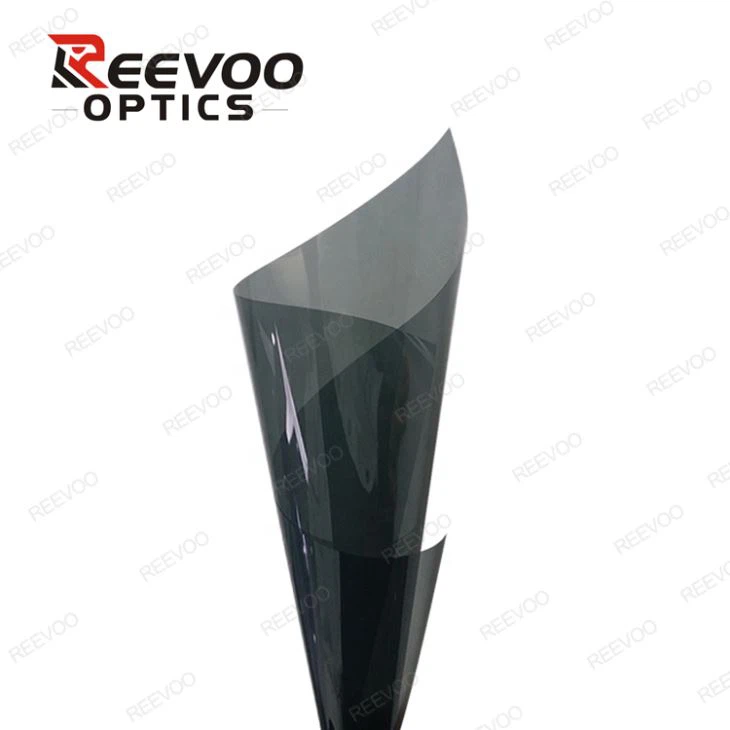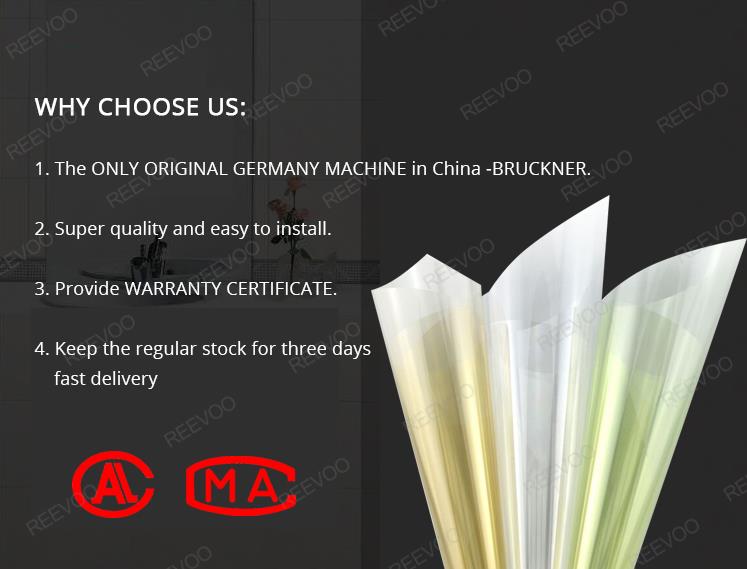
Infrared Reflective Film
Why Choose Nano Ceramic Window Films: 1. Advanced Nano-Ceramic Materials 2. No Corrosion or Fading 3. State of the Art Construction 4. Spectrally Selective 5. High Optical Clarity, Low Reflectivity 6. No Electromagnetic Interference 7. 10 Years Longtime Warranty
- Fast Delievery
- Quality Assurance
- 24/7 Customer Service
Product Introduction
Reflective films are called antireflective films, also known as antireflective films. Their main function is to reduce or eliminate the reflected light from optical surfaces such as lenses, prisms, and planar mirrors, thereby increasing the transmittance of these elements and reducing or eliminating stray light from the system.
Anti reflective film is one of the most widely used and widely produced optical thin films. Therefore, it is still an important research topic in optical thin film technology. The focus of research is to find new materials, design new film systems, improve the deposition process, use the minimum number of layers, the simplest and most stable process, obtain the highest possible yield, and achieve the most ideal effect.
The function of the reflective film is to increase the reflectivity of the optical surface. Reflective films can generally be divided into two categories, one is metal reflective films, and the other is all dielectric reflective films. In addition, there is a metal dielectric reverse film that combines the two.
Generally, metals have a large extinction coefficient. When a light beam enters the metal surface from air, the amplitude of the light entering the metal rapidly attenuates, resulting in a corresponding decrease in the light energy entering the metal, while the reflected light energy increases. The greater the extinction coefficient, the faster the attenuation of light amplitude, the less light energy entering the metal interior, and the higher the reflectivity. People always choose metals with large optical coefficients and stable optical properties as metal film materials. The commonly used metal thin material in the ultraviolet region is aluminum, aluminum and silver are commonly used in the visible region, and gold, silver, and copper are commonly used in the infrared region. In addition, chromium and platinum are also commonly used as film materials for some special films. Because materials such as aluminum, silver, and copper are easily oxidized in air and degrade their performance, they must be protected with dielectric membranes. Commonly used protective film materials include silicon monoxide, magnesium fluoride, silicon dioxide, aluminum trioxide, and so on.
The advantages of metal reflective film are simple preparation process and wide working wavelength range; The disadvantage is that the light loss is large and the reflectivity cannot be very high. In order to further improve the reflectivity of the metal reflective film, several layers of dielectric layers with a certain thickness can be plated on the outer side of the film to form a metal dielectric reflective film. It should be noted that metal dielectric films increase the reflectivity of a certain wavelength (or a certain wave region), but undermine the neutral reflection characteristics of metal films.
All dielectric reflective films are based on multi beam interference. In contrast to antireflective films, coating an optical surface with a thin film with a refractive index higher than that of the substrate material can increase the reflectivity of the optical surface. The simplest multilayer reflection is formed by alternating evaporation of two materials with high and low refractive indices, and the optical thickness of each layer of film is one-fourth of a certain wavelength. Under this condition, the reflected light vectors on each interface participating in the superposition have the same vibration direction. The synthetic amplitude increases as the number of thin film layers increases.
➤
product type
Dike aluminum foil thermal insulation coiled material, also known as barrier film, thermal insulation film, thermal insulation foil, heat extraction film, reflective film, etc. It is made of aluminum foil veneer, polyethylene film, fiber woven fabric, and metal coating film by laminating with hot melt adhesive. The Dike aluminum foil insulation roll has the functions of heat insulation, water resistance, and moisture resistance. Aluminum foil thermal insulation coiled material has a very low solar absorption rate (solar radiation absorption coefficient) (0.07), and has excellent thermal insulation performance, which can reflect more than 93% of the radiation heat. It is widely used for building roof and exterior wall thermal insulation.
➤
Product Principles
Heat transfer in buildings can be expressed in three ways: conduction+convective heat<25%, and radiant heat>75%.
After the temperature of the tile roof rises in summer, a large amount of radiant heat enters the room, resulting in a continuous rise in temperature, making the working and living environment extremely uncomfortable.
The solar radiation absorption coefficient (normal total radiation emissivity) of the Dike aluminum foil thermal insulation coil is 0.07, with little radiation heat. It is widely used for thermal insulation of roofs and walls.
Thermal energy transmission route (without thermal insulation film): the sun - infrared magnetic waves - thermal energy impacts tiles to raise the temperature - tiles become heat sources to emit thermal energy - thermal energy impacts cast-in-place roofs to raise the temperature - cast-in-place roofs become heat sources to emit thermal energy - indoor ambient temperatures continue to rise.
Thermal energy transmission route (with thermal insulation film): the sun - infrared magnetic waves - thermal energy hitting the tiles increases the temperature - the tiles become heat sources to emit thermal energy - thermal energy hitting the aluminum foil increases the surface temperature - the aluminum foil emits extremely low emissivity, emitting a small amount of thermal energy - maintaining a comfortable ambient temperature indoors.
➤
Resolution method
What are heat absorbing and reflective films
Currently, the common automotive thermal insulation films on the market are divided into heat absorbing films and reflective films in principle. A heat absorbing film uses a heat absorbing adhesive coated on the surface of a transparent polyester film to absorb infrared rays to achieve thermal insulation, while a reflective film uses a layer of metal or nanoscale ceramic material splashed onto the transparent polyester film to reflect infrared rays to achieve thermal insulation.
Difference between heat absorbing film and reflective film
The heat absorbing adhesive of the heat absorbing film can absorb heat energy (infrared ray in the solar spectrum), but the heat absorbed by the heat absorbing adhesive can easily reach saturation. When the heat absorbed by the heat absorbing adhesive is saturated, the heat absorbing adhesive will re radiate the absorbed heat into the vehicle in a far infrared manner, making people feel even drier and hotter. The reflective film reflects infrared rays outside the vehicle, eliminating the problem of secondary radiation, thereby fundamentally solving the problem of heat insulation.
How to distinguish between heat absorbing film and reflective film
Method 1: It can be identified from the test method. Due to the fact that reflective thermal insulation films do not have the problem of heat saturation, no matter how much high-power iodine-tungsten lamps (at least 500W, preferably 1000W) are used to irradiate reflective thermal insulation films for a long time, the thermal insulation effect will not be affected. However, endothermic films cannot be irradiated with high-power iodine-tungsten lamps for too long. Therefore, many dealers of endothermic thermal insulation films do not have large power of iodine-tungsten lamps for testing, and the testing time is strictly limited, Due to a slightly longer exposure time, the thermal insulation effect of the endothermic thermal insulation film will gradually lose.
Method 2: Reflection test. Due to the fact that the reflective thermal insulation film insulates heat by reflecting infrared rays, it is possible to select a small piece of glass and apply the anti thermal thermal insulation film. Then, place the glass covered with the film in front of the heat source under test, and rotate the angle of the glass while feeling it with your face. It is obvious that the glass reflects heat onto your face; Similarly, when replaced with an endothermic insulation film and tested using the same method, no heat will be reflected.
Method 3: Glue removal test method. The endothermic thermal insulation film uses endothermic adhesive to absorb heat, so it can be identified by removing the adhesive. First, take a piece of endothermic and reflective thermal insulation film at the same time, use alcohol, carburetor cleaner, tar cleaner, or professional adhesive remover to remove the adhesive layer of the thermal insulation film, and then conduct a test. At this time, it can be found that the thermal insulation performance of the endothermic thermal insulation film no longer exists, The thermal insulation effect of the reflective thermal insulation film has hardly changed.



Why Choose Nano Ceramic Window Films:
1. Advanced Nano-Ceramic Materials
2. No Corrosion or Fading
3. State of the Art Construction
4. Spectrally Selective
5. High Optical Clarity, Low Reflectivity
6. No Electromagnetic Interference
7. 10 Years Longtime Warranty







Hot Tags: infrared reflective film, China infrared reflective film manufacturers, suppliers, factory








